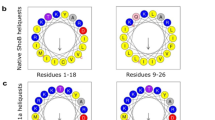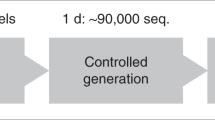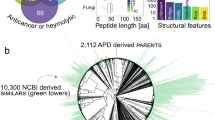Abstract
The antimicrobial effect of antimicrobial peptides is typically slow; they can be rapidly biodegraded and often have non-selective toxicity and elaborate sequences. Here we report a short peptide that is activated by ultrasound, that shows high broad-spectrum antibacterial efficiency (>99%) against clinically isolated methicillin-resistant bacteria (specifically, Staphylococcus aureus, Escherichia coli, Staphylococcus epidermidis, Enterobacter cancerogenus and Pseudomonas aeruginosa) with 15 min of ultrasound irradiation, and that has negligible toxicity and low self-antibacterial activity. We selected the peptide, FFRKSKEK (a segment from the human host-defence LL-37 peptide), from a library of peptides with piezoelectric diphenylalanine (FF) sequences, low toxicity, hydrophobicity and net positive charge. We show via all-atom molecular dynamics simulations that ultrasound amplifies the membrane-penetrating ability of peptides with FF sequences and that its piezoelectric polarization generates reactive-oxygen species and disturbs bacterial electron-transport chains. In a goat model of hard-to-treat intervertebral infection, the sonosensitive peptide led to better outcomes than vancomycin. Antimicrobial peptides activated by ultrasound may offer a clinically relevant strategy for combating antibiotic-resistant infections.
This is a preview of subscription content, access via your institution
Access options
Access Nature and 54 other Nature Portfolio journals
Get Nature+, our best-value online-access subscription
$32.99 / 30 days
cancel any time
Subscribe to this journal
Receive 12 digital issues and online access to articles
$119.00 per year
only $9.92 per issue
Buy this article
- Purchase on SpringerLink
- Instant access to full article PDF
Prices may be subject to local taxes which are calculated during checkout






Similar content being viewed by others
Data availability
The data supporting the results in this study are available within the paper and its Supplementary Information. The raw and analysed datasets generated during the study are available for research purposes from the corresponding authors on reasonable request. Source data are provided with this paper.
References
Willyard, C. The drug-resistant bacteria that pose the greatest health threats. Nature 543, 15 (2017).
Wanted: a reward for antibiotic development. Nat. Biotechnol. 36, 555 (2018).
Hancock, R. E. W., Alford, M. A. & Haney, E. F. Antibiofilm activity of host defence peptides: complexity provides opportunities. Nat. Rev. Microbiol. 19, 786–797 (2021).
Ji, S. et al. Antimicrobial peptides: an alternative to traditional antibiotics. Eur. J. Med. Chem. 265, 116072 (2024).
Gagnon, M. C. et al. Influence of the length and charge on the activity of α-helical amphipathic antimicrobial peptides. Biochemistry 56, 1680–1695 (2017).
Jiang, Y., Chen, Y., Song, Z., Tan, Z. & Cheng, J. Recent advances in design of antimicrobial peptides and polypeptides toward clinical translation. Adv. Drug Deliv. Rev. 170, 261–280 (2021).
Mourtada, R. et al. Design of stapled antimicrobial peptides that are stable, nontoxic and kill antibiotic-resistant bacteria in mice. Nat. Biotechnol. 37, 1186–1197 (2019).
Thapa, R. K., Diep, D. B. & Tønnesen, H. H. Topical antimicrobial peptide formulations for wound healing: current developments and future prospects. Acta Biomater. 103, 52–67 (2020).
Yu, Y. et al. Single-atom catalysis for efficient sonodynamic therapy of methicillin-resistant Staphylococcus aureus-infected osteomyelitis. ACS Nano 15, 10628–10639 (2021).
Lo, P. C. et al. The unique features and promises of phthalocyanines as advanced photosensitisers for photodynamic therapy of cancer. Chem. Soc. Rev. 49, 1041–1056 (2020).
Valsami-Jones, E. & Lynch, I. NANOSAFETY. How safe are nanomaterials? Science 350, 388–389 (2015).
Zelenovskii, P. S. et al. 2D layered dipeptide crystals for piezoelectric applications. Adv. Funct. Mater. 31, 2102524 (2021).
Yan, X., Zhu, P. & Li, J. Self-assembly and application of diphenylalanine-based nanostructures. Chem. Soc. Rev. 39, 1877–1890 (2010).
Cottle, L. & Riordan, T. Infectious spondylodiscitis. J. Infect. 56, 401–412 (2008).
Gouliouris, T., Aliyu, S. H. & Brown, N. M. Spondylodiscitis: update on diagnosis and management. J. Antimicrob. Chemother. 65, 11–24 (2010). Suppl 3, iii.
Urban, J. P. & Roberts, S. Degeneration of the intervertebral disc. Arthritis Res. Ther. 5, 120–130 (2003).
Nagashima, H. Spinal infections. In Brain and Spine Surgery in the Elderly. (eds Berhouma, M. & Krolak-Salmon, P.) 305–327 (Springer, 2017).
Zhu, Q. et al. Transport of vancomycin and cefepime into human intervertebral discs: quantitative analyses. Spine 44, E992–e999 (2019).
Bue, M. et al. Vancomycin concentrations in the cervical spine after intravenous administration: results from an experimental pig study. Acta Orthop. 89, 683–688 (2018).
Jackson, A. R. et al. Diffusion of antibiotics in intervertebral disc. J. Biomech. 76, 259–262 (2018).
Herren, C. et al. Spondylodiscitis: diagnosis and treatment options. Dtsch. Arztebl. Int. 114, 875–882 (2017).
Berbari, E. F. et al. 2015 infectious diseases society of America (IDSA) clinical practice guidelines for the diagnosis and treatment of native vertebral osteomyelitis in adults. Clin. Infect. Dis. 61, e26–e46 (2015).
Scott, M. G., Davidson, D. J., Gold, M. R., Bowdish, D. & Hancock, R. E. W. The human antimicrobial peptide LL-37 is a multifunctional modulator of innate immune responses. J. Immunol. 169, 3883–3891 (2002).
Chemes, L. B., Alonso, L. G., Noval, M. G. & de Prat-Gay, G. Circular dichroism techniques for the analysis of intrinsically disordered proteins and domains. Methods Mol. Biol. 895, 387–404 (2012).
Kim, D. et al. Biomolecular piezoelectric materials: from amino acids to living tissues. Adv. Mater. 32, e1906989 (2020).
Standard test method for analysis of hemolytic properties of nanoparticles. ASTM E2524-08 (ASTM, 2013).
Piggot, T. J., Holdbrook, D. A. & Khalid, S. Electroporation of the E. coli and S. aureus membranes: molecular dynamics simulations of complex bacterial membranes. J. Phys. Chem. B 115, 13381–13388 (2011).
Kim, W. et al. A new class of synthetic retinoid antibiotics effective against bacterial persisters. Nature 556, 103–107 (2018).
Man, V. H. et al. Molecular mechanism of ultrasound interaction with a blood brain barrier model. J. Chem. Phys. 153, 045104 (2020).
Man, V. H., Li, M. S., Wang, J., Derreumaux, P. & Nguyen, P. H. Interaction mechanism between the focused ultrasound and lipid membrane at the molecular level. J. Chem. Phys. 150, 215101 (2019).
Nguyen, L. T., Haney, E. F. & Vogel, H. J. The expanding scope of antimicrobial peptide structures and their modes of action. Trends Biotechnol. 29, 464–472 (2011).
Skogman, M. E., Vuorela, P. M. & Fallarero, A. Combining biofilm matrix measurements with biomass and viability assays in susceptibility assessments of antimicrobials against Staphylococcus aureus biofilms. J. Antibiot. 65, 453–459 (2012).
Qiao, Y. et al. Microwave assisted antibacterial action of Garcinia nanoparticles on Gram-negative bacteria. Nat. Commun. 13, 2461 (2022).
Su, R. et al. Nano-ferroelectric for high efficiency overall water splitting under ultrasonic vibration. Angew. Chem. Int. Ed. Engl. 58, 15076–15081 (2019).
Torres, M. D. T. et al. Mining for encrypted peptide antibiotics in the human proteome. Nat. Biomed. Eng. 6, 67–75 (2022).
Belenky, P. et al. Bactericidal antibiotics induce toxic metabolic perturbations that lead to cellular damage. Cell Rep. 13, 968–980 (2015).
Hicks, K. A. et al. Structural and biochemical characterization of 6-hydroxynicotinic acid 3-monooxygenase, a novel decarboxylative hydroxylase involved in aerobic nicotinate degradation. Biochemistry 55, 3432–3446 (2016).
Khakhina, S. et al. Control of plasma membrane permeability by ABC transporters. Eukaryot. Cell 14, 442–453 (2015).
Kawase, H. et al. Extracellular glutamate concentration increases linearly in proportion to decreases in residual cerebral blood flow after the loss of membrane potential in a rat model of ischemia. J. Neurosurg. Anesthesiol. 33, 356–362 (2021).
Huang, Y., Lemieux, M. J., Song, J., Auer, M. & Wang, D. Structure and mechanism of the glycerol-3-phosphate transporter from Escherichia coli. Science 301, 616–620 (2003).
Ramos-Martín, F. & D’Amelio, N. Biomembrane lipids: when physics and chemistry join to shape biological activity. Biochimie 203, 118–138 (2022).
Goto, A., Mizuike, A. & Hanada, K. Sphingolipid metabolism at the ER-Golgi contact zone and its impact on membrane trafficking. Contact 3, 2515256420959514 (2020).
Aon, M. A. et al. Untangling determinants of enhanced health and lifespan through a multi-omics approach in mice. Cell Metab. 32, 100–116.e4 (2020).
Björck, M. L. & Brzezinski, P. Control of transmembrane charge transfer in cytochrome C oxidase by the membrane potential. Nat. Commun. 9, 3187 (2018).
Hall-Stoodley, L., Costerton, J. W. & Stoodley, P. Bacterial biofilms: from the natural environment to infectious diseases. Nat. Rev. Microbiol. 2, 95–108 (2004).
Schnaider, L. et al. Self-assembling dipeptide antibacterial nanostructures with membrane disrupting activity. Nat. Commun. 8, 1365 (2017).
Beirao, S. et al. Photodynamic inactivation of bacterial and yeast biofilms with a cationic porphyrin. Photochem. Photobiol. 90, 1387–1396 (2014).
Vyas, N. et al. How does ultrasonic cavitation remove dental bacterial biofilm? Ultrason. Sonochem. 67, 105112 (2020).
Guo, W. et al. Hyaluronic acid-based interpenetrating network hydrogel as a cell carrier for nucleus pulposus repair. Carbohydr. Polym. 277, 118828 (2022).
Matsuzaki, K. Control of cell selectivity of antimicrobial peptides. Biochim. Biophys. Acta 1788, 1687–1692 (2009).
Poole, R. K. & Cook, G. M. Redundancy of aerobic respiratory chains in bacteria? Routes, reasons and regulation. Adv. Microb. Physiol. 43, 165–224 (2000).
Schmidtchen, A., Frick, L.-M., Andersson, E., Tapper, H. & Björck, L. Proteinases of common pathogenic bacteria degrade and inactivate the antibacterial peptide LL-37. Mol. Microbiol. 46, 157–168 (2002).
Breidenstein, E. B. M., de la Fuente-Nunez, C. & Hancock, R. E. W. Pseudomonas aeruginosa: all roads lead to resistance. Trends Microbiol. 19, 419–426 (2011).
Schweizer, T. A. et al. Intervertebral disc cell chondroptosis elicits neutrophil response in Staphylococcus aureus spondylodiscitis. Front. Immunol. 13, 908211 (2022).
Babic, M. & Simpfendorfer, C. S. Infections of the spine. Infect. Dis. Clin. North Am. 31, 279–297 (2017).
Kar, B., Venishetty, N., Kumar Yadav, S. & Sakale, H. Use of vancomycin mixed bone graft and vancomycin mixed saline wash before wound closure reduces the rate of infection in lumbar spine fusion surgery. Cureus 13, e17275 (2021).
Binch, A. L. A., Fitzgerald, J. C., Growney, E. A. & Barry, F. Cell-based strategies for IVD repair: clinical progress and translational obstacles. Nat. Rev. Rheumatol. 17, 158–175 (2021).
Ziegler, A., Gonzalez, L. & Blikslager, A. Large animal models: the key to translational discovery in digestive disease research. Cell Mol. Gastroenterol. Hepatol. 2, 716–724 (2016).
Daly, C., Ghosh, P., Jenkin, G., Oehme, D. & Goldschlager, T. A review of animal models of intervertebral disc degeneration: pathophysiology, regeneration, and translation to the clinic. BioMed Res. Int. 2016, 5952165 (2016).
Sloan, S. R. Jr. et al. Combined nucleus pulposus augmentation and annulus fibrosus repair prevents acute intervertebral disc degeneration after discectomy. Sci. Transl. Med. 12, eaay2380 (2020).
Rybak, M. J. et al. Therapeutic monitoring of vancomycin for serious methicillin-resistant Staphylococcus aureus infections: a revised consensus guideline and review by the American Society of Health-System Pharmacists, the Infectious Diseases Society of America, the Pediatric Infectious Diseases Society, and the Society of Infectious Diseases Pharmacists. Am. J. Health Syst. Pharm. 77, 835–864 (2020).
Hussain, S. et al. Antibiotic-loaded nanoparticles targeted to the site of infection enhance antibacterial efficacy. Nat. Biomed. Eng. 2, 95–103 (2018).
Lu, D. S. et al. Effects of chondroitinase ABC and chymopapain on spinal motion segment biomechanics - An in vivo biomechanical, radiologic, and histologic canine study. Spine 22, 1828–1834 (1997).
Coin, I., Beyermann, M. & Bienert, M. Solid-phase peptide synthesis: from standard procedures to the synthesis of difficult sequences. Nat. Protoc. 2, 3247–3256 (2007).
ter Haar, G. Therapeutic applications of ultrasound. Prog. Biophys. Mol. Biol. 93, 111–129 (2007).
Jumper, J. et al. Highly accurate protein structure prediction with AlphaFold. Nature 596, 583–589 (2021).
Van Der Spoel, D. et al. GROMACS: fast, flexible, and free. J. Comput. Chem. 26, 1701–1718 (2005).
Jorgensen, W. L., Chandrasekhar, J., Madura, J. D., Impey, R. W. & Klein, M. L. Comparison of simple potential functions for simulating liquid water. J. Chem. Phys. 79, 926–935 (1983).
Hess, B., Bekker, H., Berendsen, H. J. C. & Fraaije, J. G. E. M. LINCS: a linear constraint solver for molecular simulations. J. Comput. Chem. 18, 1463–1472 (1997).
Darden, T., York, D. & Pedersen, L. Particle mesh Ewald: an N⋅log(N) method for Ewald sums in large systems. J. Chem. Phys. 98, 10089–10092 (1993).
Martoňák, R., Laio, A. & Parrinello, M. Predicting crystal structures: the Parrinello-Rahman method revisited. Phys. Rev. Lett. 90, 075503 (2003).
Berendsen, H. J. C. et al. Molecular dynamics with coupling to an external bath. J. Chem. Phys. 81, 3684–3690 (1984).
Cheng, X. et al. Circular RNA VMA21 protects against intervertebral disc degeneration through targeting miR-200c and X linked inhibitor-of-apoptosis protein. Ann. Rheum. Dis. 77, 770–779 (2018).
Wiegand, I., Hilpert, K. & Hancock, R. E. Agar and broth dilution methods to determine the minimal inhibitory concentration (MIC) of antimicrobial substances. Nat. Protoc. 3, 163–175 (2008).
Bridgen, D. T. et al. Regulation of human nucleus pulposus cells by peptide-coupled substrates. Acta Biomater. 55, 100–108 (2017).
Lam, S. J. et al. Combating multidrug-resistant gram-negative bacteria with structurally nanoengineered antimicrobial peptide polymers. Nat. Microbiol. 1, 16162 (2016).
Ye, Y. et al. Bioactive hydrogel encapsulated dual-gene engineered nucleus pulposus stem cells towards intervertebral disc tissue repair. Chem. Eng. J. 453, 139717 (2023).
Feng, X. et al. Piezo-augmented sonosensitizer with strong ultrasound-propelling ability for efficient treatment of osteomyelitis. ACS Nano 16, 2546–2557 (2022).
Acknowledgements
This work was supported by the Natural Science Foundation of China (numbers 82372380, 22175058, 82130072, 82272459, 82072505, 51801056), Natural Science Foundation of Hubei Province (2023AFB770) and the National Key Research and Development Plan of China (number 2020YFC2006000).
Author information
Authors and Affiliations
Contributions
L.T., X.Z. and C.Y. conceived and designed the study. X.Z., X.F., L.M., J.L., G.L., W.Z. and H.L. performed the experiments. X.Z., L.T., D.W. and B.T. analysed and interpreted the data. The manuscript was written by L.T. and X.Z.
Corresponding authors
Ethics declarations
Competing interests
The authors declare no competing interests.
Peer review
Peer review information
Nature Biomedical Engineering thanks Jianfeng Cai, Francesca Cavalieri, Ebru Oral, Tzanko Tzanov and the other, anonymous, reviewer(s) for their contribution to the peer review of this work. Peer reviewer reports are available.
Additional information
Publisher’s note Springer Nature remains neutral with regard to jurisdictional claims in published maps and institutional affiliations.
Extended data
Extended Data Fig. 1 Spread plate assay after antimicrobial activity of 15 peptides against MRSA and then performed analysis.
The antibacterial activities of 15 peptides against MRSA under US or without US for 15 min. The data are presented as means ± s.d., with n = 5 biological replicates. Statistical analysis was performed using one-way ANOVA. ns: no significant.
Extended Data Fig. 2 Spread plate assay for self-antibacterial efficiency of the peptides.
Antibacterial activities of 15 peptides (without US) incubated with MRSA at 37 °C for 18 h. Data are means ± s.d., with n = 5 biological replicates. Statistical analysis was performed using one-way ANOVA.
Extended Data Fig. 3 The toxicity of the peptides to the NP-derived cells was calculated by MTT and LDH assays.
a, The effect of 15 peptides with gradient concentrations on the viability of NP-derived cells. The IC50 is extracted in curve according to MTT assay; n = 6. b, The effect of FFRK8’s gradient concentration on the viability of NP-derived cells. The IC50 is extracted in curve according to LDH assay. n = 6. Data and error bars in (a,b) represent the mean ± s.d., with n = 6 biological replicates.
Extended Data Fig. 4 Investigation of optimal ultrasonic antimicrobial conditions for FFRK8 peptide.
Antibacterial experiments on MRSA using different concentrations of FFRK8 under US. The experimental results of spread-plate assay are respectively presented in the form of antibacterial efficiency (a) and counting of CFU/mL (b). c, After undergoing 15 min of antibacterial treatment with FFRK8+US, the supernatant was either removed by centrifugation or left intact, and then the treated MRSA were cultured in a 96-well plate. After 24 h of incubation, the absorbance at 600 nm was measured. n = 6. d, Antibacterial ability of FFRK8 with US treatment for 15 and 30 min, respectively. Panels b and d are shown as mean ± s.d. n = 5 biological replicates. Statistical significance was calculated using one- (b) or two-way (d) ANOVA.
Extended Data Fig. 5 Biocompatibility testing of peptides.
a, Representative live/dead fluorescence staining of HAMA hydrogel loaded BMSCs and paravertebral fibroblasts treated with FFRK8, US, and FFRK8+US for 15 min. Green fluorescence stained by Calcein dye indicates live BMSCs and paravertebral fibroblasts cells, and red fluorescence stained by PI dye represents dead cells. b,c, Mean fluorescence intensity (MFI) visually quantifies the green and red fluorescence intensity (arbitrary units; a.u.) of BMSCs and paravertebral fibroblasts. ns: no significant. The values are presented as mean ± s.d. of n = 3 biological replicates, and were calculated using two-way ANOVA. d,e, Testing of IC50 of FFRK8 peptide on BMSCs and paravertebral fibroblasts. Cell viability of BMSCs and paravertebral fibroblasts treated by FFRK8. Data and error bars represent the mean ± s.d., with n = 3 biological replicates.
Extended Data Fig. 6 Ultrasonic antimicrobial broad-spectrum testing of the FFRK8 peptide.
Antibacterial activities of the peptides against S. aureus, MRSA, E. coli, S. epidermidis, E. cancerogenus, and P. aeruginosa. The values are presented as mean ± s.d. of n = 5 biological replicates, and were calculated using two-way ANOVA.
Extended Data Fig. 7 Imaging and histology of intervertebral anti-infection experiments in rats.
a, Reconstructed 3D images according to micro-CT. b, Nuclear magnetic resonance imaging (MRI) of intervertebral disk (IVD) of rats and corresponding X-ray images as background. c, Histological staining of Masson. d, Immunohistochemistry staining of Col2a1 and Mmp13.
Supplementary information
Source data
Source Data
Statistical source data for main figures and extended figures.
Rights and permissions
Springer Nature or its licensor (e.g. a society or other partner) holds exclusive rights to this article under a publishing agreement with the author(s) or other rightsholder(s); author self-archiving of the accepted manuscript version of this article is solely governed by the terms of such publishing agreement and applicable law.
About this article
Cite this article
Zhang, X., Feng, X., Ma, L. et al. A sonosensitive diphenylalanine-based broad-spectrum antimicrobial peptide. Nat. Biomed. Eng 9, 1349–1365 (2025). https://doi.org/10.1038/s41551-025-01377-w
Received:
Accepted:
Published:
Issue date:
DOI: https://doi.org/10.1038/s41551-025-01377-w
This article is cited by
-
Antimicrobial peptides boosted by ultrasound
Nature Biomedical Engineering (2025)



